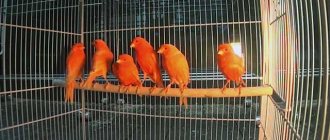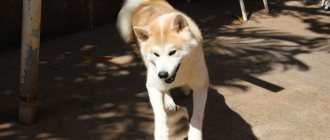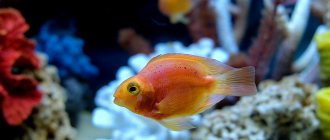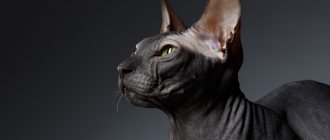Habitat and characteristics of the breed
Rodents of this breed are not found in the wild; they are bred specifically for decorative purposes. The name of the animal was given by a Disney elephant calf, which differs from other representatives of its species by its large ears.
The characteristic features of the Dumbo rat are:
- Large, compared to the size of the rest of the body, low-set, rounded ears
- Pear-shaped short body
- Pointed muzzle
- A long tail
The size of the dumbo rat is practically no different from the size of its relatives; weight – up to 400 grams, length – up to 20 cm. Of course, there are larger individuals, but they are quite rare.
What affects life expectancy
Dumbo rats are unpretentious, so they have managed to adapt to living conditions in many countries. At minimal cost, owners get a cute pet with an easy-going character and extraordinary intelligence.
Conditions of detention
Rats feel great in small cages (60x40x60cm) with metal bars. The cage must have:
- deep plastic tray;
- solid bottom;
- wide doors;
- shelves;
- stairs;
- ropes.
The Dumbo family is very friendly, so several rodents can easily fit into the cage. Together they feel completely comfortable: they do the cleaning and brush out the fur.
A small house inside the cage will add comfort to the Dumbo rats. Babies love to retire and take a nap in silence. Adult pets will appreciate a warm hammock; they will be happy to spend their leisure time there.
Wood or corn filler will help eliminate the specific odor from the rat family. Sometimes owners try to lay napkins or toilet paper on the bottom, but this option is not suitable for rats. Regular cleaning will also help keep the cage clean. Twice a week it is necessary to remove leftover food and used filler, change the water in the drinking bowl, and carry out disinfection.
Dumbos at home should live in a warm room where there are no drafts and moisture. Rats are very sensitive to sharp sounds, blinding light, and overheating. They get tired of people's annoying attention.
Diet
Dumbo rats, unlike rodents that live in the wild, are very sensitive to the consumption of low-quality food. Poor nutrition can easily provoke gastrointestinal disorders and allergies, so owners will have to create a diet according to certain rules.
The rat's menu must include:
It is strictly forbidden to give Dumbo rats fatty and fried food from the master's table, alcohol, sausage, sprouted potatoes, green bananas. The quality of the food should not be in doubt, otherwise the pet will become ill.
Young rats are fed 3–4 times a day. Adult pets need only two meals a day.
It is important to remove uneaten food debris so that the rodent does not eat spoiled pieces.
Hygiene
Dumbo rats are real clean people. They clean their fur and wash themselves, so you don’t have to bathe them often. Water procedures will be required if the pet gets very dirty. Rats, unlike other pets, love to swim. They can splash around in warm water for a long time.
Bathing is carried out with special shampoos in a warm room without drafts. It is necessary to ensure that water does not get into your pet’s ears, which can lead to hearing loss. After bathing, the rat is wrapped in a warm towel and dried well. If the room is cold, it is better to dry the fur with a warm stream from a hairdryer.
One of the dangers of swimming is hypothermia. A frozen rat can easily catch a cold. Therefore, in the cold season, the doors and windows in the room are tightly closed, and a heater is placed near the cage.
Entertainment
Caring for and maintaining Dumbo rats means not only food and a cozy home, but also a kind of gym. In the absence of the owner, the animals entertain themselves by climbing ropes and rope ladders, and passing through tunnels. Some craftsmen make toys for pets on their own.
Character and lifestyle
Since Dumbo is not a separate species of animal, but only one of the rat breeds, the same traits can be traced in their character as in ordinary rodents:
- intelligence
- sociability
- good sense of smell
- friendliness
Dumbo is distinguished from its relatives by its inactivity and low activity. Although there are often exceptions to this rule.
Rodents need communication; they should be given at least 2 hours every day. Otherwise, rats may get bored and stop eating. If the future owner does not have so much time, he can buy a friend for his pet.
Description of the breed
Dumbo rats have large ears on a small skull. The shape of the auricle differs in different species, they are:
- pointed;
- round and flat;
- slightly curled;
- resembling half-open petals with a pointed tip.
The animals have a short, pear-shaped body with greatly expanded pelvic bones. Males reach a length of 18-20 cm, body weight ranges from 250 to 500 mg. Females reach 15 cm and weigh about 250-400 g. Dumbo differ from other types of ornamental rats by a wide and flat skull with a blunt muzzle, and a longer tail.
On average, Dumbo rats live about 2-3 years. Life expectancy strictly depends on the quality of feeding and care of the pet. With timely treatment of diseases and a balanced diet, rodents can live to a ripe old age and delight their owners for 5 years.
Types of dumbo rats
There are several varieties of the Dumbo breed, differing in coat color.
Dumbo Rex Rat
A characteristic feature of the Rex is its strong, curly fur. There are rats of different colors: white, black and gray. In some cases, a baby may be born with variegated fur consisting of 3 or more colors. When removed over a considerable distance, the rodent without movement resembles a soft toy. In addition to fur, the rat has curled antennae. When you carefully examine the animal, you will notice thick and wavy fur, which will be rough when touched.
Dumbo Siamese rat
Rats of this species are distinguished by dark tails, paws and the front of the muzzle, which resemble Siamese cats. Areas of black or brown fur create a sharp contrast against the white body fur. Cubs rarely inherit this color. Siamese rodents are irritable and often show aggression towards their owners.
Dumbo sphinx rat
For people predisposed to allergies to wool, there is a special type of Dumbo - the Sphynx. Rats are completely hairless. Rodents are warm and soft to the touch, their skin is quite delicate and traumatic. The skin may not only have a pink color. There are animals with chocolate, white and bluish colors. These rats were specially bred through numerous crossings and genetic mutations.
Dumbo Husky Rat
Husky is rare. Such rats are often called chameleons due to the change in coat color throughout life. If a rodent baby is born with a white-gray, black or brown coat, it may later change to a new coat with white patterns.
Dumbo rat blue mink
The rarest variety of Dumbo rats is the blue mink, which is characterized by a purple-blue fur color. The texture of rodent fur can vary. The most common animals are those with straight, smooth hair. Rats with curly fur or long hairs on their faces are considered more expensive.
Dumbo Manx Rat
Features of behavior and character of the Dumbo rat
Smart rats quickly find a common language with people and get used to being picked up. They fearlessly climb over humans, displaying friendliness and sociability. Dumbo has a good sense of smell, so their activity increases when the owner approaches with various treats: sweet fruits, sugar or grains. At the same time, in everyday life, rats are not very mobile. They love to snooze at the bottom of the cage, basking in the sun's rays.
Rats are social animals, so without the attention of the owner or other relatives, they begin to get bored. Zoologists recommend purchasing rodents in quantities of several pieces.
Care and maintenance
Cell
Domestic Dumbo rats, like other rodents, are kept in a cage. It is best to choose a spacious metal cage
Ideal cell for Dumbo paint
Wooden and plastic rods can be easily chewed or damaged by rodents.
Selection of accessories
In the rodent's home you need to place:
- a house or hammock where the rat will rest and sleep
- various exercise equipment, toys, ladders
- mineral stone for grinding teeth
- special drinking bowl and food bowl
Remember that the cage should not be left in the sun or placed in a draft. The optimal temperature for keeping a pet is 20-22 degrees
Litter selection
Wood shavings or thick paper are ideal as bedding. You should not choose small sawdust: a rodent can accidentally inhale them, which will entail negative consequences and contribute to the manifestation of allergies.
Tip 類: sawdust can be bought in poultry stores or where they sell feed. The price per bag is 200-300₽. When a small bag in a pet store costs 70₽.
Caring for and keeping Dumbo rats involves cleaning the cage as it gets dirty, on average 1-2 times a week. Once a month it must be disinfected.
Accessories for rats
It is advisable that your pet have the following items in his cage:
- drinking bowl for water;
- food feeder;
- a place where the animal will sleep (house);
- mineral stone so that your pet can sharpen its teeth.
To make life more interesting for a rodent, you can place toys in its house. Rats really like this thing called a hammock. You can buy it in a store or make it yourself from fabric. Most of all, rodents love such entertainment as stairs, labyrinths, and tunnels.
Nutrition and prohibited foods
It is important to know exactly what to feed your dumbo rat. Proper nutrition will help keep your pet active and extend its life.
First of all, you need to carefully ensure that the rat always has clean water. The drink should be changed daily.
The diet of a Dumbo rat should be rich in nutrients and vitamins. It is useful to feed them with grain: oats, wheat, barley. To diversify the diet, you can add boiled liver to animal food: kidneys, liver, heart. Rodents should be given nuts to wear down their teeth.
Dumbo loves fresh apples, peaches, ripe bananas, and cherries. But you need to be careful with dried fruits: they contain a high sugar content.
Knowing what dumbo rats eat, you should exclude the following foods from their diet:
- fatty fried foods
- raw potatoes
- radish, turnip, radish
- cabbage
- artichokes
- legumes
- citrus
- mushrooms
- dairy
- sweets
Many people are interested in the question of whether it is possible to feed a dumbo rat with sausage or meat. The answer is clear: you can’t. Sausages contain a large amount of preservatives, spices and salt, which are dangerous for rodents. The same applies to meats that are high in fat.
Small rodents are fed no more than twice a day, adult Dumbo rats more often: three to four.
What do rats eat?
They eat everything, but they also have taste preferences. The diet of rats must include grain crops: wheat, oats, rye, soybeans.
For an animal to be in excellent health, it needs not only plant crops, but also animal proteins. They are found in any meat, fish, minced meat, various seafood and butter. Rodents will also benefit from dairy products.
Vegetables should be given to rodents in small quantities:
- radish;
- fresh cabbage;
- greenery;
- eggplant;
- zucchini.
Treats for rodents include dried fruits, sweets, pure sugar and, of course, any type of hard cheese. There are foods that are best not included in rat food at all, these include pineapples and citrus fruits.
To ensure that the animal does not have problems in development and health, it should be fed properly. To prevent abnormal tooth regrowth, it is necessary to allow your pet to chew hard food; too much soft food will lead to problems.
Diseases and treatment
If the animal is sick, it is quite easy to see. So, a healthy rat is active, has shiny fur and shiny eyes. When an animal feels unwell, the following symptoms appear:
- poor appetite or refusal to eat;
- sluggish appearance;
- strong unpleasant odor of excrement;
- dull coat, etc.
If you notice signs of illness in your pet, contact your veterinarian immediately. Don't forget: some rodent diseases are dangerous to humans.
The most common infectious diseases of rats are:
| Name | Symptoms | Treatment |
| Mycoplasmosis | sneezing; discharge of a specific color from the nose and eyes; labored breathing; lethargy, etc. | Antibiotics, hormones, anti-inflammatory drugs prescribed by a doctor. If left untreated, the disease can be fatal to the rodent. |
| Rabies | lethargy followed by frantic activity; fear of bright light; aggression, etc. | The disease is incurable, the rodent must be euthanized, and the room where it was kept must be disinfected to avoid infecting other animals and people. |
| Pneumonia | sneezing; discharge of a specific color from the nose and eyes; labored breathing; refusal of food; increased drowsiness. | Antibiotics, anti-inflammatory drugs prescribed by a doctor. |
Pros and cons of rats as a pet
Decorative rats are smart and friendly, but they like to sharpen their teeth on various objects.
On the part of people, the attitude towards decorative rats is ambiguous. You can find both supporters and opponents of keeping these animals. If a person dislikes the very sight of rodents, he will not be interested in them.
For those who love these smart and nimble animals, it is important to know about all the pros and cons of keeping them. This will help you decide on the choice of pet.
Pros:
- Developed intellectual abilities, thanks to which rats quickly get used to the owner and are able to guess his mood.
- With proper persistence on the part of the owner, they can be trained.
- Lack of aggression towards humans, relatives and pets.
- Requires little space for content.
- There will be no need to spend a lot on purchasing feed.
- Omnivorous.
- They quickly get used to children and allow them to play with them.
- Simple care, mostly consisting of cleaning the cage or other rat house.
Minuses:
- In a state of fear or physical pain, they may bite.
- The average lifespan is 2–3 years. Once you become attached to a pet, it is difficult to cope with its loss.
- If kept freely, the rat will inevitably chew on various objects, furniture, shoes.
- If the smell of food comes from your fingers, the rat may bite.
- People with a sensitive sense of smell may not like the smell emanating from their pet. But most owners don't notice it.
How to determine gender
The sex of adults can be determined quite easily. To do this, you just need to carefully study the structure of their genitals.
Things are more complicated with baby rats. Their gender can be determined with certainty only a few days after birth.
To determine the gender of a small rodent, you need to pay attention to its tummy, which is still completely devoid of fur. If we can see two rows of nipples, which during this period resemble small pimples, we have a girl; if not, we have a boy.
If you want to keep several rats, but are not going to breed them, choose girls. It will be easier for females to get along together than for males, who will periodically engage in fights for leadership, territory and food.
Training and playing with your pet
The variety of types of games with a rat will surprise you
Decorative rats have a natural intelligence, which makes them easy to train. It has been noticed that individuals with colored fur are more capable of learning. White rats are more inert. In addition, their eyesight is worse.
Rules for training decorative rats:
- The last meal should be 10–12 hours before the start of classes. In this case, the pet will be more active in seeking the treat.
- The maximum lesson duration is 30 minutes.
- Before starting training, the animal is given the opportunity to sniff and explore the place where the lesson will take place. In this case, the rat will not be distracted by unknown odors.
- Training is carried out starting with the reinforcement of random movements and actions. If the pet jumps over any object, reward it with a treat and return it to its original position.
- They complicate the task only after the previous actions have been fully practiced and consolidated.
Tricks that decorative rats can perform:
- jump over an object;
- jumping through a hoop;
- searching for treats in the maze;
- walking on hind legs;
- taking a piece of paper out of the box;
- choosing a specific item from several located next to each other;
- running up stairs (including rope stairs).
Playing together brings pleasure to both the owner and his pet. Most popular toys:
- small balls (ideally from table tennis);
- beautiful pieces of paper;
- matchboxes filled with treats.
Watching your pet play is interesting and educational. The game reveals the character of the rat, and the owner begins to better understand his pet.
Pregnancy and childbirth
A rat's pregnancy lasts just over 20 days; a rounded tummy becomes noticeable by the end of the first week after mating. While bearing offspring, the female needs special attention and careful care. She needs to be provided with adequate nutrition and vitamins.
To give birth in a cage, you should prepare a place where the rodent can retire. If there is no such place, then the expectant mother will make herself a nest from materials found in the home.
The duration of labor is 2-3 hours; one litter can have up to 15 babies.
How to care for newborn rat pups
The female takes care of her offspring herself. The owner can only take care of the mother’s good nutrition and the cleanliness of the cage.
It is strictly forbidden to handle baby rats under two weeks of age. This can anger the female and lead to the death of the offspring.
Reproduction and lifespan of the Dumbo rat
Breeding Dumbo rats will require a male and a female at least six months old. Pregnancy lasts three weeks, after which up to eight pups are born.
From about the twentieth day of life, the young generation can be switched to adult food, and by the age of one and a half months, the pups become completely independent.
After the babies are born, the male should be placed in another cage for several weeks. How long do dumbo rats live ? Their life expectancy in very rare cases exceeds three years.
Choosing a name, examples of names
Every owner wants to choose a bright and original name for their pet. If you follow simple rules, the chosen name for the Dumbo rat will fully meet these requirements:
- it should be easy to understand and short (bad: Archibald, Wilhelmina; good: Archie, Willie);
- It is advisable to use sonorant (r, l, m, n) and hissing (zh, sh, ts, h) consonants in the nickname (bad: Doug, Alice; good: Ricky, Mila).
It is best to purchase a rat from a nursery. This will not only allow you to gain confidence in the authenticity of the chosen breed, but will also significantly expand the number of possible options for the color and texture of the coat. In addition to the usual rodent of this breed, you can buy there:
- Siamese
- rex
- blue
- husky
- white
Types of decorative rats
There are several varieties of the Dumbo breed:
Siamese
The color of the Siamese is similar to that of the cat breed of the same name: white or light beige fur and a small brown spot on the face.
The color of the husky is similar to the color of the coat of the dog breed of the same name: white coat with dark spots on the body and head.
The Rex's long curly coat, hairs and whiskers are slightly curled.
Sphinx
There is no wool. The skin is thin, soft and warm. The main advantage of the species is its inability to cause allergies.
A cage with metal bars is needed so that the animal cannot chew them. It must be installed in a place that is not in a draft, in direct sun, near a radiator or heater. The cage size for 1-2 rats is at least 60x40x30 cm.
The room temperature should not fall below +20 degrees, otherwise there is a high probability of your pet catching a cold.
The cage contains attributes for entertainment and sleep: a house, a wheel, pipes, ladders.
Large sawdust or dry granules are suitable as filler.
You cannot put newspaper paper in a cage.
When wet, it emits toxic substances contained in printing ink, which causes great damage to the health of the animal.
The filler is changed every 2-3 days. Once every 15-17 days, all elements of the house are treated with a disinfectant.
Dry air can harm your pet's health, so the humidity in the room should be 50-55%.
Dumbos are friendly and easy to get along with if treated affectionately. It is forbidden to talk loudly near the animal, shout at it, hit it, push it hard, sharply grab it or pick it up.
When the cage is heavily soiled, Dumbo rats can squeak loudly; when there is a lack of food, they can rattle the feeder or stand on their hind legs next to it.
To grind down teeth, rats are provided with wooden sticks made from hardwood.
Dumbos are distinguished by their friendliness and easy-going nature, so they easily get along with other animals. The main problem becomes the character of the rat's neighbor.
These animals do not like to sit in a cage all the time, so they need to be walked around the house. The owner needs to be careful: there is a risk of not noticing the pet and stepping on it. In addition, your pet may chew on wires.
Bathing is often prohibited, only in cases of extreme necessity. These animals are susceptible to colds. In case of local contamination, you can remove the dirt with a damp cloth.
Interesting facts about Dumbo:
- This species has very unusual ears, in fact, because of this, the rats got their name - in honor of the elephant of the same name from the cartoon;
- Dumbo rats were bred in California laboratories in 1991; they were brought to Russia in the 2000s from England;
- Dam rats grow to 15-20 centimeters, males weigh 250-500 grams, and females 200-400 grams;
- Scientists still do not know why such a mutation occurred and lop-eared rats appeared. The big-eared gene is recessive, so not all Dumbo babies will have big ears;
- Domestic rats are sweet, trusting and cunning creatures: they easily find hidden food and easily navigate in space.











